For Honor’s warriors were real people in ye olden days, and they’re brutal
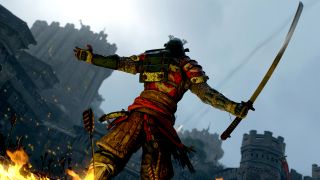
For Honor is a real cacophony of violence. Everyone is more or less familiar with Vikings, Samurais, and Knights from just generally being aware that - for a few hundred years - different nations had their own special ways of killing other humans. But where does each class in For Honor actually come from? And what did they do? Were there Wardens, Valkyries or Shugokis wandering around the world in ye olden days? Spoilers: yes, indeed there were. I’ve dug into the history of For Honor’s blood-thirsty battlers to find out exactly where they came from, and how this impacts their in-game murdering...
Kensei
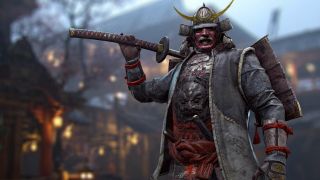
By the sounds of it Kensei are just straight-up samurai. Kensei (剣聖) translates into ‘master swordsman’, so they’re pretty good with a blade. For Honor’s description of them mentions that they’re trained to “fight and die for the emperor”. Although loyalty was definitely important to samurai, most swore allegiance to a clan or lord, and opinion about where the Emperor came in terms of importance was largely split. Do you obey your master over everyone else, or side with the ultimate authority when it comes to disputes? Samurai were arguing about this way back in 1350.
Another key component of For Honor’s Kensei is Bushidō, the way of the warrior. Going hand-in-hand with the life of a samurai, it’s comparable to the European code of chivalry among Knights. Consider it a ‘how to’ guide when it comes to being a samurai, as it emphasises righteousness, courage, compassion, respect, integrity, honor, loyalty, and self-control. The nodashi (or if you’re being picky, ōdachi) swords that these warriors wield in For Honor were used by samurai too, as a much longer version of the famed katana. So, if you want to go pure samurai in the game, it doesn’t get much more traditional than the Kensei.
Nobushi

Make way for the partly historically-accurate (but undeniably intimidating) Nobushi. Nobushi means ‘mercenary’, which explains why For Honor describes this class as “defenders of the villages too far from the Imperial City for the army to reach”. After all, hiring someone to defend your home sounds pretty smart to me if you know there’s no hope of the army saving you in time. But anyway, let’s have a chat about their weapon: the naginata.
A ton of formidable onna-bugeishas (female warriors belonging to the nobility) wielded the naginata throughout history. As wives of samurais, they were taught how to use the weapon with deadly efficiency. One of them called Nakano Takeko was the head of the female group of fighters who fought independently in the Battle of Aizu as they weren’t allowed to join the main army (insert big exasperated sigh here). But my god - Takeko didn’t need the army. Her attacks with the naginata were so fierce, her reputation so brutal, that she asked her sister to cut off her head when she was dead so it couldn’t be taken as a prize by their enemies. So if you see a Nobushi running towards you in For Honor, perhaps you should remember Takeko and get out of the way.
Shugoki

These chaps are a hybrid of myth and reality, and fearsome to boot. Someone on Reddit translated Shugoki (守護鬼) as being the combination of the word guard (守護) and demon (鬼). Sure enough, their weapon of choice - the giant club kanabo - was wielded by Oni (Japanese demons) as well as samurai. Their mask looks very similar to Japanese depictions of Oni too, with its tusks and grimace, so perhaps it’s no surprise that For Honor describes them as having the “strength of a demon”.
As for For Honor describing them as being “guardians of [their] people” bit - I couldn’t find any evidence that villages had guardians. But Shugoki are noticeably… rotund, so perhaps they’ve been partly inspired by sumos. Matches fought by these hulking figures were between representatives from each province, so local pride was probably fairly strong. Shugoki probably have the same clout as sumos in their hometown. Plus I won’t lie, the idea of one of those terrifying masked fighters having a soft spot for his village makes them a little less grim. Just a little, though.
Orochi
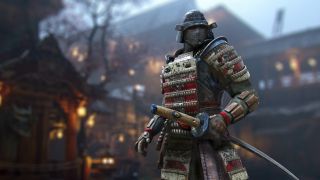
I can understand why the design team shied away from using the more accurate term to describe these misfits, so let me spell it out for you: Orochi are ninjas. Well, Orochi is actually a name for a devious eight-headed serpent (Yamata no Orochi, 八岐の大蛇) found in Japanese myth. The nod to this famous reptile doesn’t appear to go any further. However, the description of the Orochi looks to be heavily inspired by ninjas.
Roaming the “battlefield like ghosts” and using “the arts of stealth and deception”, they’re undoubtedly most similar to pop culture’s well known masters of sneakiness. Ninjas are a sect of the samurai family too, trained to fill a niche for covert tasks and espionage. Most sources agree that the katana was the ninja’s weapon of choice, along with shuriken and light bamboo bows - though we won’t be seeing the latter in For Honor.
Warden
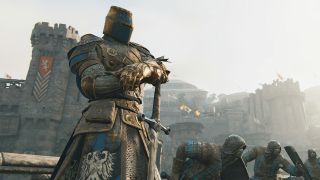
Just like the Kensei and the samurai, the Wardens are the closest thing to real knights. Described as “powerful, noble warriors” who are “proud, loyal, and brilliant diplomats, the Wardens are expect to embody the highest values of Knighthood”. Those highest values would be chivalry, a code of behaviour put forward to denote the expectations of Knights.
Popularised in the literature of the time, especially in Le Morte Darthur (which is where we get our stories of King Arthur and the knights of the round table), it explained that amongst other things, knights should be brave, truthful, generous, and “respect all weaknesses, and shalt constitute thyself the defender of them”. Just looking at a Warden tells you that they certainly look the part of the knight. In case you needed any other evidence, just look to their blade. The longsword was wielded predominantly by knights in 16th century duels. I wouldn’t advise getting in the way of it.
Conqueror

You can probably guess some of the context for this one, but allow me to clarify. Conquerors are partly based on warriors from the Crusades, a religious war where various Christian forces attempted to capture Jerusalem from Muslim armies. These Crusades were ultimately unsuccessful, but along the way the Pope proclaimed that any criminal would be forgiven if they joined the Crusades - and came back in one piece (that’s the tricky bit). So convicts could sign up, just like For Honor’s “ex-prisoner” Conquerors who were “originally pressed into military service as sword fodder”.
But this is where reality and fiction split, as it’s highly unlikely that any convicts made it back from the Crusades, plus For Honor doesn’t imply that the Conquerors were recruited for religious wars. Their weapon, the footman’s flail, is a nice touch that hints at their ordinary roots. The flail was wielded by peasants as an improvised weapon as it was usually used in farming, but don’t be fooled: its metal version is undeniably more lethal.
Sign up to the GamesRadar+ Newsletter
Weekly digests, tales from the communities you love, and more
Peacekeeper

If only the Peacekeeper existed in real life. I want nothing more than an Assassin’s Creed-like covert operative to have roamed around medieval England, but any evidence that Europe had their own version of these specialised troops is lost to time. However, there were the fida’yin in 12th-century Persia (modern Iran), who were trained in the art of assassination.
Just like the Peacekeepers, fida’yin carried poison-tipped daggers and, being skilled in the art of espionage, could certainly “win a fight before their enemy even knows they are there”. However, that doesn’t mean there weren’t assassinations in Europe. Far from it, in fact, and there was one weapon which far outnumbered any use of daggers: poison. There was even a professional Italian poisoner called Guilia Tofana, who would sell deadly concoctions to women looking to poison their husbands. I can’t imagine the Peacekeeper keeping her distance and using poison though - she seems to be far too fond of her stabby-stabby dagger and shortsword.
Lawbringer
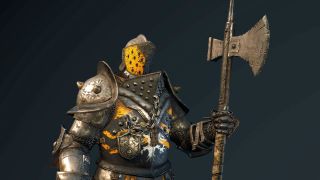
These heavily-armoured fighters might look like a knight, but in reality they have more in common with the medieval incarnation of English law enforcement. Lawbringers, as “the justice” incarnate who “enforce the laws and dispense punishment”, are similar to the role that constables and bailiffs played way back when English nobility used to live in castles. The police didn’t really exist before the 19th century, so in the 13th century constables would collect evidence of crimes, and way before that they looked after all the local weapons in case nearby villages were attacked.
For the more heavy-handed side of the law, Lawbringers also echo bailiffs. If you get on the wrong side of the law, bailiffs are the ones you’ll run into. Much like now, bailiffs in ‘ye olden times’ are the ones who collected debts. In pop culture they’re commonly depicted as heavy-set with features intimidating enough to make you think twice about taking them on. I don’t know about you, but to me the Lawbringer certainly fits that bill.
Valkyrie
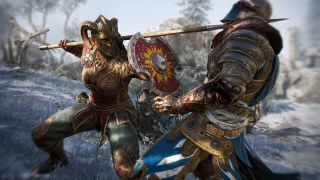
These fearsome warriors are taken straight from Norse myth with almost no tweaks, because they’re so iconic they simply don’t need to be changed. Valkyries are fighters who “are chosen by the gods”, which is accurate enough - except in real Norse myth, they don’t “fight and earn glory” to bag a space in Valhalla for those who can’t lift a sword. Their original purpose is a bit more sinister.
During a raging battle Valkyries pick who dies (and so makes it to Valhalla, the glorious Norse afterlife for warriors), and who lives. Only thing is, they’re not above using malicious magic to make sure those who they pick meet their grisly end. Icelandic sagas describe them as having spears, so even though For Honor’s Valkyrie don’t have quite the same level of control over life and death on the battlefield, they’re wielding the same legendary weapons as described centuries ago. Unfortunately I doubt very much that the Valkyrie can fly like her mythic forbears.
Raider

These chaps embody our idea of Vikings being muscle-clad, horned-helmet wearing fighters, but Raiders are actually more similar to Scandinavia’s housecarls. Yes, that’s the same word used to describe burden-bearing Lydia in Skyrim. Historically housecarls were soldiers or bodyguards assigned to a particular person. Ready to spring into action at a moment’s notice to protect their master, they were fierce and incredibly loyal. Prized like family by those they protected, even today you can see runestones dotted across Sweden’s landscape in memory of outstanding housecarls who died centuries ago.
In battle they were likely as fearsome as For Honor’s Raiders, who “embody the Viking ideals: boundless bravery, spotless integrity, and unbridled passion”. Plus, housecarls for King Harold in England way back in 1066 are depicted in the Bayeux Tapestry as wielding long axes, which - sure enough - is the weapon of choice for For Honor’s Raiders.
Warlord
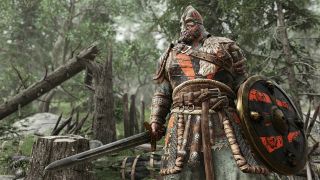
If you came up against a Goði (i.e. Chieftain, the plural being Goðar - now you know a smattering of medieval Icelandic) in medieval Iceland, you should either start showing some serious respect or run in the other direction. Warlords are the mirror image (more or less) of Goðar, the rulers of clans who had earned the right to to lead through blood, gold, and influence. Not just using blunt force to get their way, Goðar made sure they showed their suitability to rule either by giving gifts to their followers or hosting magnificent feasts.
Like For Honor’s Warlords, they led “a life of service to their people”. Not surprising considering that you can bet that if they slipped up their clan would simply choose another leader. Curiously, the gladius is their weapon of choice and is usually a term used to describe a generic sword. But there’s also a specific type of Roman shortsword called a gladius - so I’ve decided the Warlord has taken one off a Roman’s corpse and is now brandishing it himself.
Berserker

If there was one foe I wouldn’t want to come up against in a fight, the Berserker would be it. “Chaotic”, “brutal”, and “savage” to the bone, these warriors definitely existed, as chess figures from the 12th Century have been found carved in their shape. During battles Vikings unleashed berserkers, who fought in a frenzy as if they were a beast - some accounts mention that they couldn’t distinguish friend from foe whilst berserking.
Some suspect that they might have ingested hallucinogenic mushrooms or gallons of alcohol to get into this state of mind. Either way, they were a formidable force on the field, so much so that their shield-gnashing tendencies (yes, really - they’d bite on their shields) were immortalised in ivory chess pieces.
The good news is that if you’re thirsty for more details about these fighters, all you have to do is turn to the history books to sate your appetite. Throughout the ages there are innumerable other warriors who have made their mark on history, and who knows: maybe other civilisations will be included in a DLC. Have you noticed any other historical precedents in For Honor’s bloodthirsty warriors? Mention them in the comments below!
While here at GamesRadar, Zoe was a features writer and video presenter for us. She's since flown the coop and gone on to work at Eurogamer where she's a video producer, and also runs her own Twitch and YouTube channels. She specialises in huge open-world games, true crime, and lore deep-dives.
Most Popular





